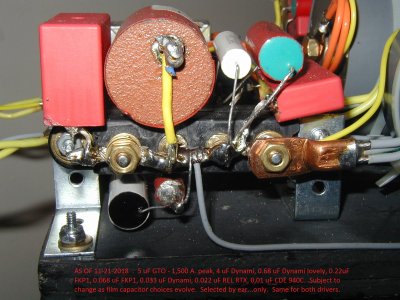hmm. The British units were better where you got inches instead of millimeters.I’m tempted with a ‘that’s what she….’ Joke.
You are using an out of date browser. It may not display this or other websites correctly.
You should upgrade or use an alternative browser.
You should upgrade or use an alternative browser.
Tilting speakers upwards or downwards
- Thread starter mbhangui
- Start date
Subbu68
Well-Known Member
Tried out this method in those videos. Got a near symmetrical positions. Did not quite get "follow my head" imaging. May be this method is not for horns? In that video I posted he says he was not quite getting this with his Klipsch. With a very acute toe-in with my Heresys I had experienced this but the stage was pretty limited.
Yes, I also questioned ....... is it more the spikes?? To find out :
You need to put all four spikes in place, to determine. If necessary, you may need to clean up the speaker's internal threads ( female ) , with a large tap, so you can easily adjust the threaded ( male ) spikes, as needed.
I would also LOVE to hear what you come up, angling the other speakers' ESL tops down, as we recently discussed. HAVE FUN. Trust what you hear, and double check.
Good luck in your explorations. Congratulations on trying and exploring, I love that you are doing that.
Jeff
Tried out this method in those videos. Got a near symmetrical positions. Did not quite get "follow my head" imaging. May be this method is not for horns? In that video I posted he says he was not quite getting this with his Klipsch. With a very acute toe-in with my Heresys I had experienced this but the stage was pretty limited.
Subbu68,
I find, with my SE amp building, that the amp itself has a LOT to do with defining the X,Y, and Z axis, and in recreating the original recording's sense of room size and instrument placement. ( This is in addition to whatever the speaker alone can do. )
The extreme top end response, on ALTEC VOTTs, with multiple film bypassed capacitors in the play back chain, defines and refines X,Y, and Z axis recreation in practice. This applies uniformly to the amplifier, amp to speaker wiring, and the crossover in one's system.
Jeff
An example of just "one" capacitor position ( one used by most people ) on my speaker's crossover. ( This would be for naught, if the amp and speaker leads, feeding this crossover, were not wide band capable, also ).

That's the reason I had asked you why you have angled your high frequency driver downwards in an another postYes, I also questioned ....... is it more the spikes?? To find out :
You need to put all four spikes in place, to determine. If necessary, you may need to clean up the speaker's internal threads ( female ) , with a large tap, so you can easily adjust the threaded ( male ) spikes, as needed.
I would also LOVE to hear what you come up, angling the other speakers' ESL tops down, as we recently discussed. HAVE FUN. Trust what you hear, and double check.
Good luck in your explorations. Congratulations on trying and exploring, I love that you are doing that.
Jeff
I wish human ears were so sensitive as to discern 0.5% difference …
When you listen to Bob Robbins' 2014 RMAF seminar, he starts out by describing how sensitive the ear and hearing is.
I would suggest there is " no problem" hearing 1/2% difference in music ( but NOT with a single sinusoidal test tone ).
Why, there are multiple things happening with music, and the human brain can make VERY fine discernments of multiple events, multiple inputs, occuring simultaneously.
BIG THANKS, for posting the above video on line.
I had only done modest room placement with my ALTEC VOTTs seven years ago, and left it constant. ( To develop amps, by ear, I was hesitant to move the speakers. ) Now that we have made design breakthroughs ( in the 2019 KT88 amp, and in 2021- 2022 with the new 6005 Finals tube amps ), I am ready to experiment in Q4 2022, on room placement . I will start this after finishing the 2022 TRIPLE 6005 monoblocks.
I truly identified with Bob Robbins, and all that he said. Glad to have found this, through HFV. Bob says to do the adjustments we need to " listen with your heart ". Amen !! This will be fun, and rewarding, I am sure.
Jeff
Last edited:
Apparently we all instinctively crave symmetry…overcoming this for the sake of better sound in irregular shaped spaces might be a bigger challenge … visual aesthetic vs auditory aesthetic?This is wisdom, IMO. I've actually seen some people refusing to have slightly unequal/assymetrical placement because of various reasons while knowing that assymetrical placement produces symmetrical left-right balance. Another option is to listen slightly off center to balance out the left and right sounds. It can be jarring visually. Proof that we do listen with our eyes too

And
Why do humans prefer symmetrical arrangement of objects?
Most of the times, we associate symmetry with beauty. The symmetry may be in architectural/interior design for instance. Why would this be so ?
I thought this illustrates the sentiment nicely (including the boat metaphor)All right ! Point taken …. I guess part of the fun is in attempting the tweaks in itself.
Whatever floats one’s boat.
Look around me
I can see my life before me
Running rings around the way
It used to be
I am older now
I have more than what I wanted
But I wish that I had started
Long before I did
And there's so much time to make up
Everywhere you turn
Time we have wasted on the way
So much water moving
Underneath the bridge
Let the water come and carry us away
Oh when you were young
Did you question all the answers
Did you envy all the dancers
Who had all the nerve
Look round you know
You must go for what you wanted
Look at all my friends who did and got what they deserved
And there's so much time to make up
Everywhere you turn
Time we have wasted on the way
So much water moving
Underneath the bridge
Let the water come and carry us away
And there's so much love to make up
Everywhere you turn
Love we have wasted on the way
So much water moving
Underneath the bridge
Let the water come and carry us away
Let the water come and carry us away
Fiftyfifty
Well-Known Member
The are a few other threads here on speaker positioning but i thought i would post this here as part of this active discussion:
I've have experienced changes as dramatic as with speaker positioning by moving furniture in the room.
Anyone else tried this?
I've have experienced changes as dramatic as with speaker positioning by moving furniture in the room.
Anyone else tried this?
Oh Yes. My many 'ears ago my recliner used to vibrate with music and when i moved it out of the room the midrange cleared upI've have experienced changes as dramatic as with speaker positioning by moving furniture in the room.
Yes, definitely. I have bookshelves (the kind with books) at the first reflection points on both sides and immediately perceived a difference. The empty room was full of resonance (on clapping). Strategic placement of furniture, covering up glass surfaces with curtains and a floor carpet or rug helped tame these bouncing sounds to a great degree.The are a few other threads here on speaker positioning but i thought i would post this here as part of this active discussion:
I've have experienced changes as dramatic as with speaker positioning by moving furniture in the room.
Anyone else tried this?
I normally get friends over to fill up the room and resolve issues with reflection and room modes.
Advantage is that they are easy to move and place.
Music sounds great when my living room is filled with friends.
Advantage is that they are easy to move and place.
Music sounds great when my living room is filled with friends.
Last edited:
It was a struggle, but once I got over “my need for symmetry “ in speaker placement I discovered new possibilities and better imaging and soundstage depth. Currently one speaker is a few inches closer than the other.
And they act as very good ‘absorbers’ and ‘diffusers’ when room acoustics are disturbed by home minister.I normally get friends over to fill up the room and resolve issues with reflection and room modes.
Advantage is that they are easy to move and place.
Music sounds great when my living room is filled with friends.
Wharfedale Linton Heritage Speakers in Red Mahogany finish at a Special Offer Price. BUY now before the price increase.
Similar threads
- Replies
- 0
- Views
- 3K
- Replies
- 0
- Views
- 2K
- Replies
- 2
- Views
- 796
- Replies
- 13
- Views
- 6K
- Replies
- 3
- Views
- 5K


